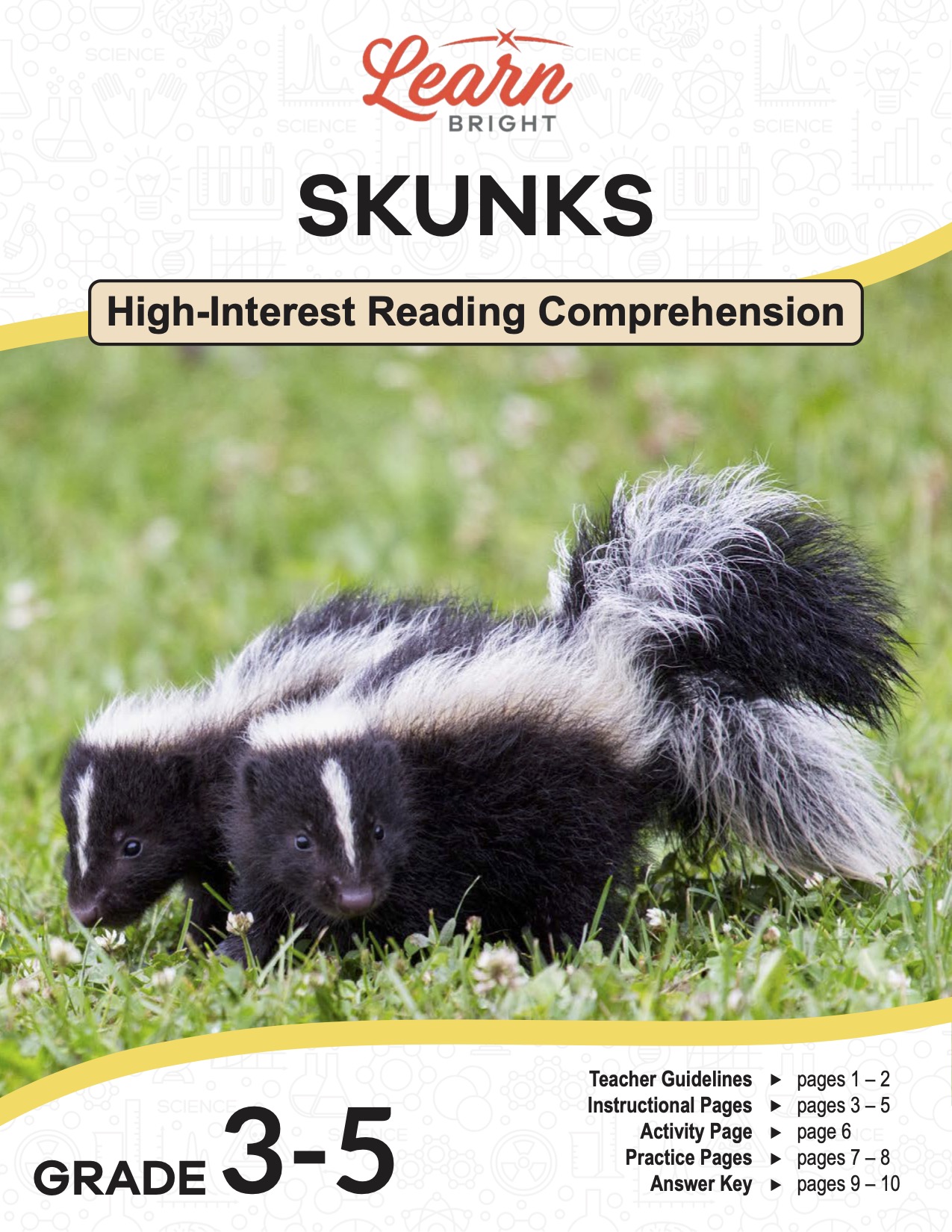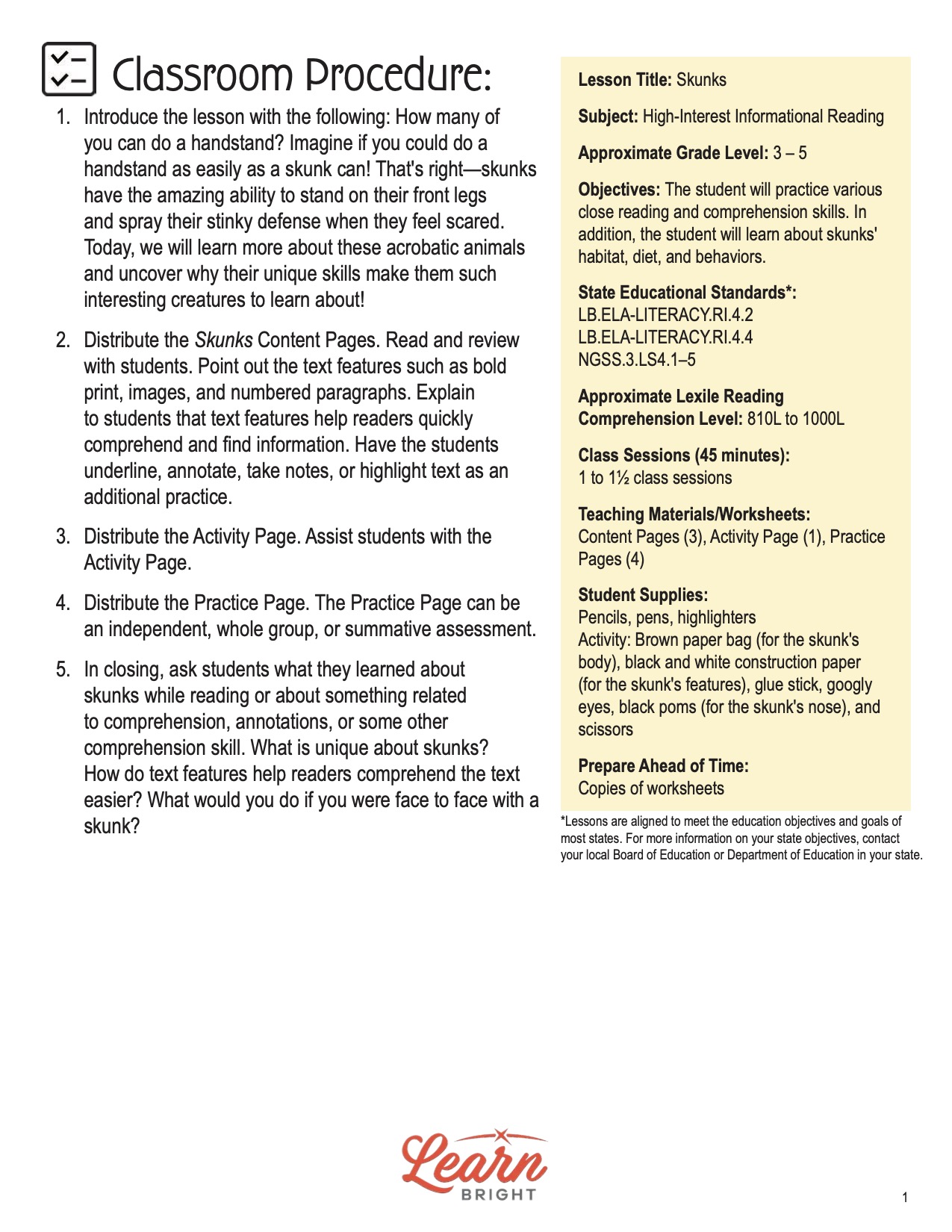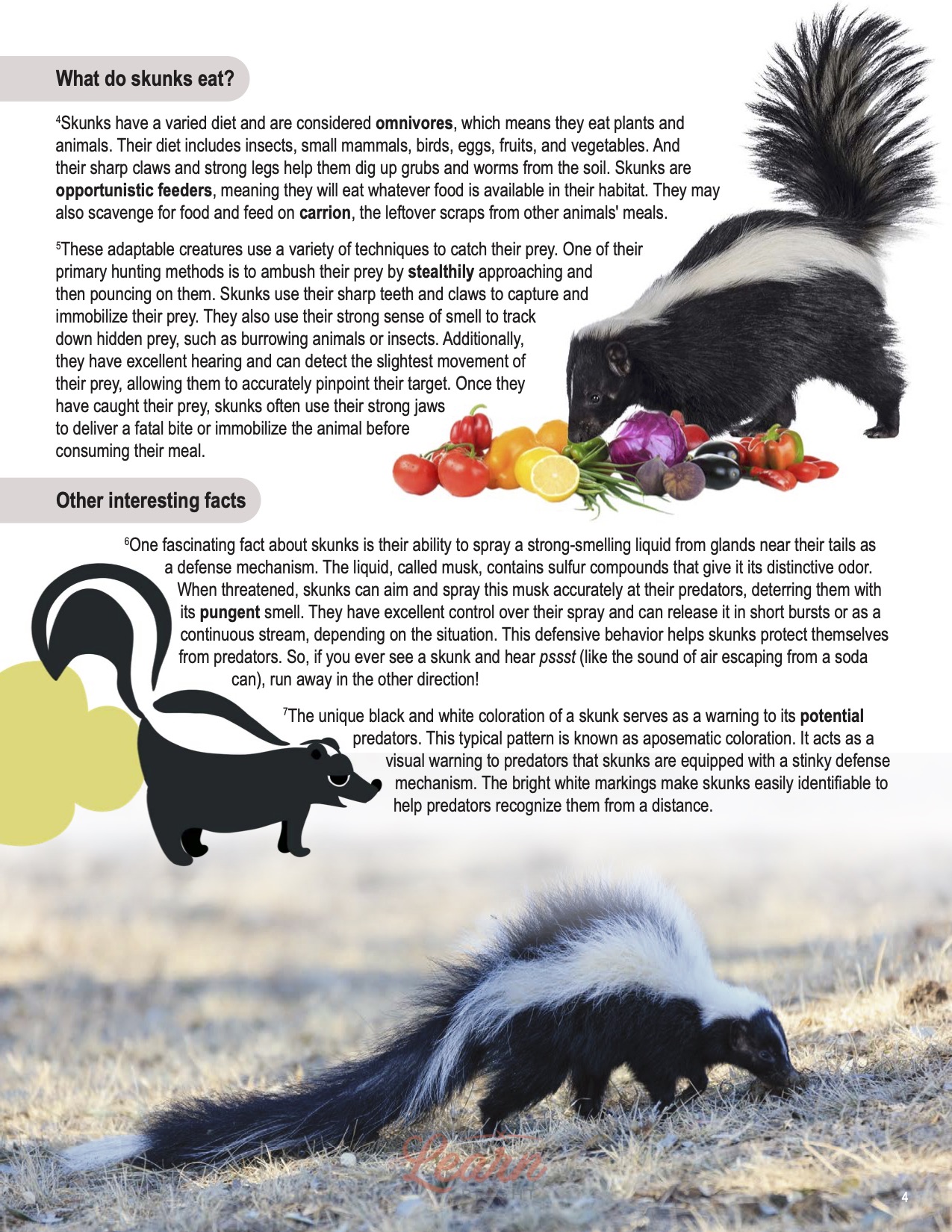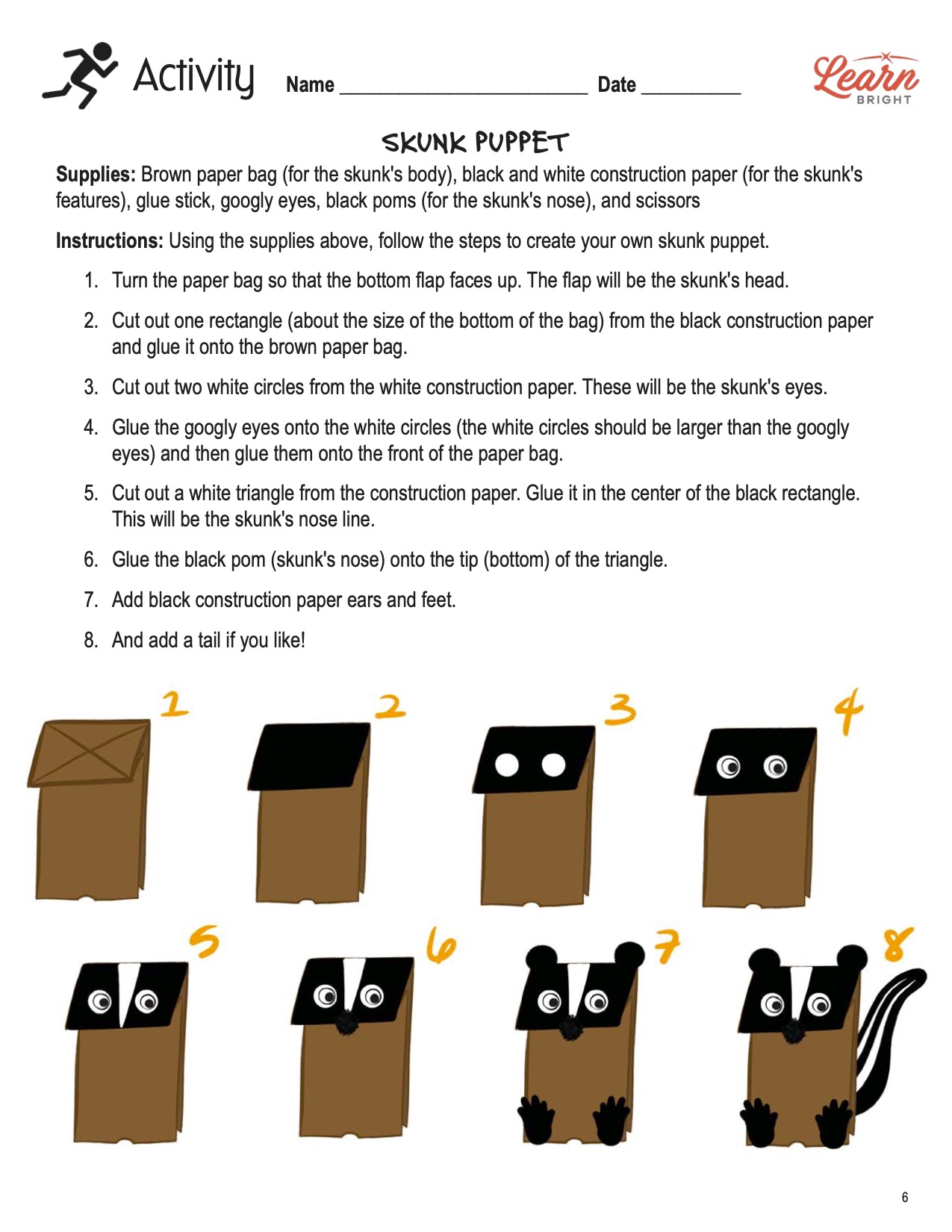Description
What our Skunks lesson plan includes
Lesson Objectives and Overview: Skunks is a high-interest reading comprehension lesson plan. As such, students will practice various close reading and comprehension skills. In addition, they will learn about the habitat, diet, and behaviors of skunks. This lesson is for students in 3rd grade, 4th grade, and 5th grade.
Classroom Procedure
Every lesson plan provides you with a classroom procedure page that outlines a step-by-step guide to follow. You do not have to follow the guide exactly. The guide helps you organize the lesson and details when to hand out worksheets. It also lists information in the yellow box that you might find useful. You will find the lesson objectives, state standards, and number of class sessions the lesson should take to complete in this area. In addition, it describes the supplies you will need as well as what and how you need to prepare beforehand. Material for this lesson include brown paper bags, black and white construction paper, black poms, and glue. See the activity page for a full list of supplies.
Teacher Notes
The paragraph on this page gives you a little more information on the lesson overall and describes what you may want to focus your teaching on. It explains that you can teach this lesson in a whole-class setting or as an independent, small-group activity. The blank lines are available for you to write out any thoughts or ideas you have as you prepare.
SKUNKS LESSON PLAN CONTENT PAGES
What Is a Skunk?
The Skunks lesson plan contains three content pages. To start off, it provides a small box with basic background information about skunks. These omnivorous mammals live in the Americas and Asia. They only live for 2 to 4 years in the wild, but their life span extends to up to 15 years if they live in captivity.
Skunks are small mammals with an iconic color pattern. Most have black fur with white stripes or spots running down their backs and tails. But they can also be brown, gray, cream, or ginger. Skunks have small heads with pointed noses and round ears. Their most famous feature is their ability to spray a strong-smelling liquid from glands near their tails, when they feel threatened. This smelly spray helps them defend themselves against predators and other threats. Skunks also have sharp claws and strong legs, which they use for digging burrows and searching for food.
Almost all 13 skunk species live in various habitats throughout North America and South America. One species, the stink badger, is native to Indonesia and the Philippines. Skunks prefer areas with plenty of vegetation and access to water sources. They are nocturnal animals, meaning they are most active at night and spend their days resting in burrows or dens. They are usually solitary animals as well, so they prefer to live alone rather than in groups. However, they may share a den with other skunks during the winter to stay warm.
A female skunk, called a sow, will give birth to a litter of baby skunks, called kits, in a den or burrow. Kits are born blind and hairless, relying entirely on their mother for warmth and nourishment. The mother skunk nurses her kits and protects them from predators until they are old enough to venture outside. As the kits grow, they learn essential survival skills from their mother, such as hunting for food and avoiding danger.
Skunk Diet
Skunks have a varied diet and are considered omnivores, which means they eat plants and animals. Their diet includes insects, small mammals, birds, eggs, fruits, and vegetables. And their sharp claws and strong legs help them dig up grubs and worms from the soil. Skunks are opportunistic feeders, meaning they will eat whatever food is available in their habitat. They may also scavenge for food and feed on carrion, the leftover scraps from other animals’ meals.
These adaptable creatures use a variety of techniques to catch their prey. One of their primary hunting methods is to ambush their prey by stealthily approaching and then pouncing on them. Skunks use their sharp teeth and claws to capture and immobilize their prey. They also use their strong sense of smell to track down hidden prey, such as burrowing animals or insects. Additionally, they have excellent hearing and can detect the slightest movement of their prey, allowing them to accurately pinpoint their target. Once they have caught their prey, skunks often use their strong jaws to deliver a fatal bite or immobilize the animal before consuming their meal.
Other Interesting Facts
One fascinating fact about skunks is their ability to spray a strong-smelling liquid from glands near their tails as a defense mechanism. The liquid, called musk, contains sulfur compounds that give it its distinctive odor. When threatened, skunks can aim and spray this musk accurately at their predators, deterring them with its pungent smell. They have excellent control over their spray and can release it in short bursts or as a continuous stream, depending on the situation. This defensive behavior helps skunks protect themselves from predators. So, if you ever see a skunk and hear pssst (like the sound of air escaping from a soda can), run away in the other direction!
The unique black and white coloration of a skunk serves as a warning to its potential predators. This typical pattern is known as aposematic coloration. It acts as a visual warning to predators that skunks are equipped with a stinky defense mechanism. The bright white markings make skunks easily identifiable to help predators recognize them from a distance.
Skunks are also known for their intelligence and resourcefulness. They are adaptable animals and thrive in various habitats, including forests, grasslands, and even urban areas. Despite their small size, they are skilled hunters and use a combination of stealth, agility, and keen senses to catch their prey.
Why Are Skunks Important to the Environment?
These fascinating animals play a vital role in the environment by helping control insect populations. They hunt and feed insects like beetles, grasshoppers, and caterpillars. By consuming these pests, skunks help keep insect populations in check, which benefits plants, crops, and other animals. Additionally, skunks are scavengers and eat carrion, which helps clean up dead animals and organic matter from their habitat. This scavenging behavior contributes to nutrient cycling and helps maintain the balance of ecosystems.
Skunks are not considered endangered, but their populations may face threats in certain areas due to habitat loss and conflicts with humans. Urbanization, agriculture, and deforestation can destroy skunk habitats, leading to population declines. They also face dangers from vehicles and domestic dogs in urban and suburban areas. Conservation efforts to protect their natural habitats and reduce conflicts between skunks and humans can help ensure their populations remain stable in the wild.
SKUNKS LESSON PLAN WORKSHEETS
The Skunks lesson plan includes two worksheets: an activity worksheet and a practice worksheet. Each one will help students solidify their grasp of the material they learned throughout the lesson. You can refer to the classroom procedure guidelines to know when to hand out each worksheet.
SKUNK PUPPETS ACTIVITY WORKSHEET
Students will get to make their own skunk puppets for this activity. Using the supplies listed on the top of the worksheet, they will follow the directions to make a puppet out of brown paper bags. Feel free to get creative and have students add other elements or use them to tell a story.
REVIEW PRACTICE WORKSHEET
The practice worksheet requires students to answer a series of 11 questions. These questions all relate to the content pages, so students will need to refer to them often for the answers. In addition, each question provides which reading tool the question corresponds to, such as text feature, vocabulary, or comprehension.
Worksheet Answer Keys
At the end of the lesson plan document is an answer key for the practice worksheet. The correct answers are all in red to make it easier for you to compare them with students’ responses. If you choose to administer the lesson pages to your students via PDF, you will need to save a new file that omits these pages. Otherwise, you can simply print out the applicable pages and keep these as reference for yourself when grading assignments.









